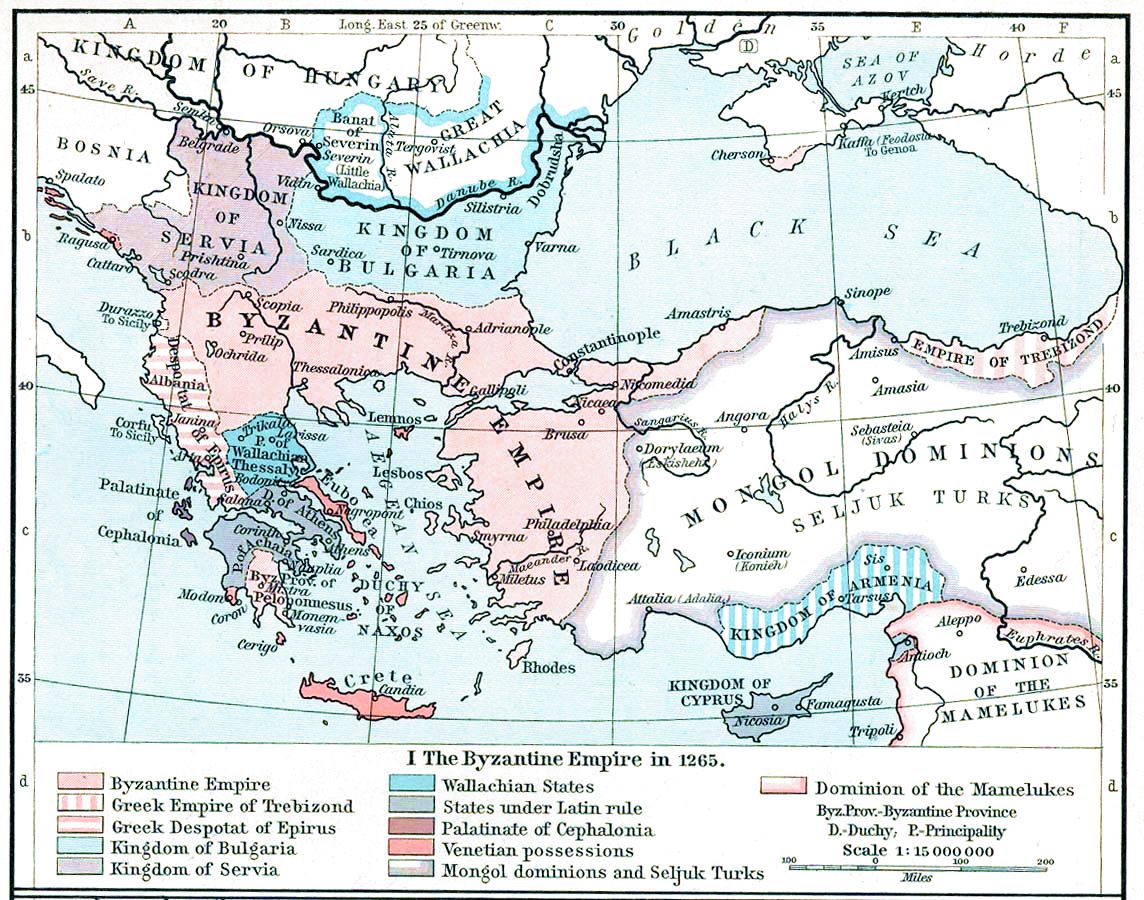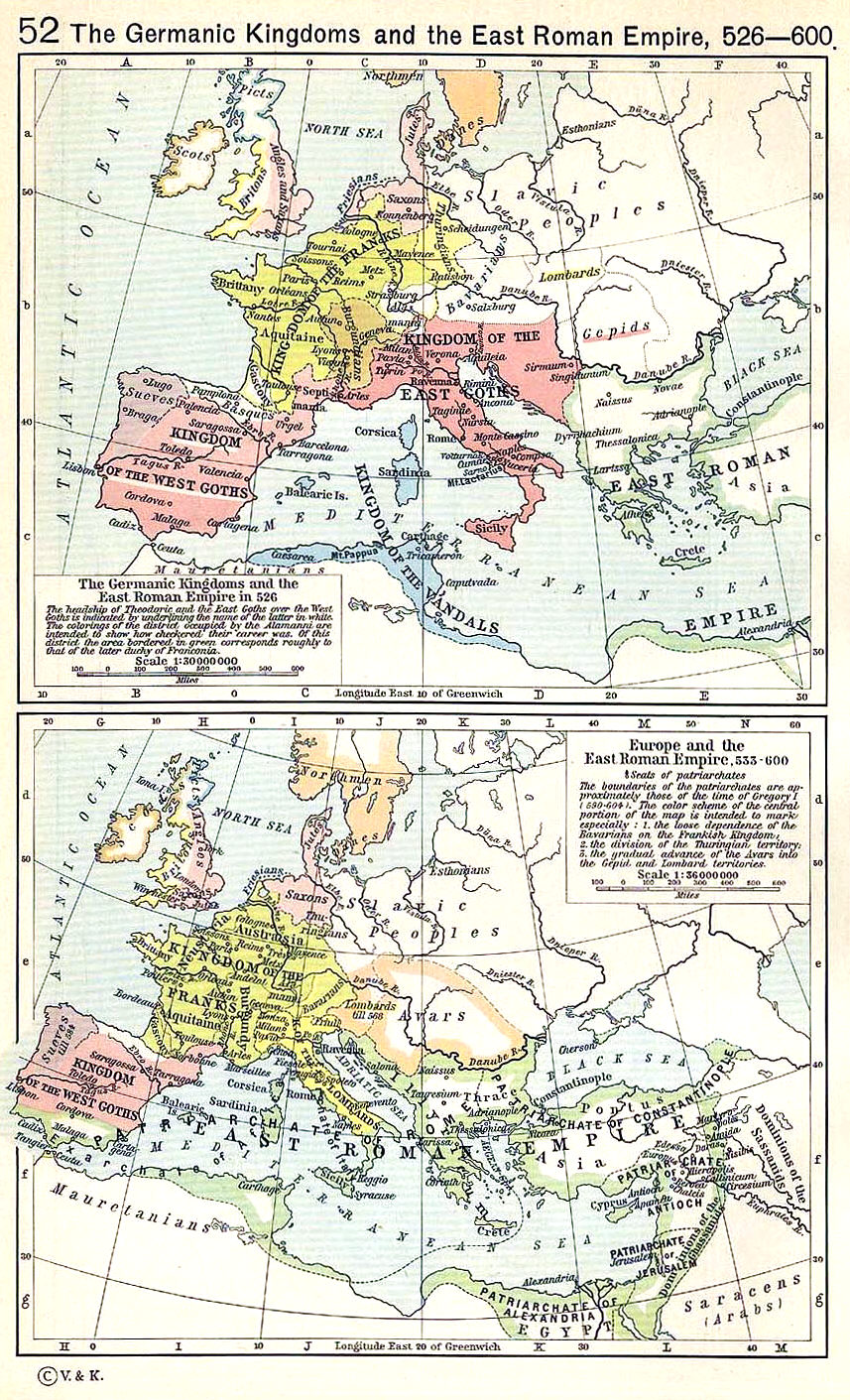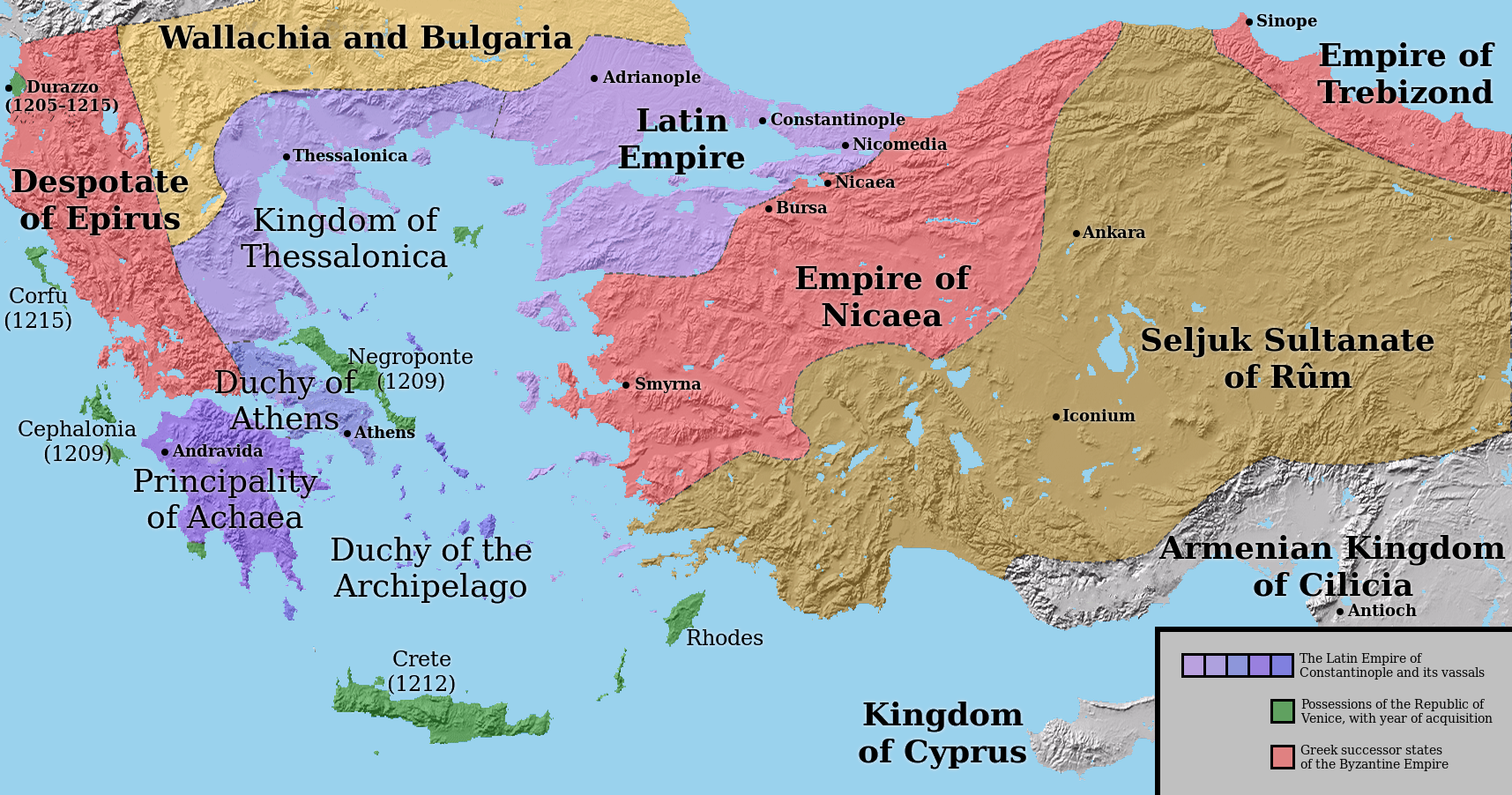|
Emperor Michael VIII
Michael VIII Palaiologos or Palaeologus (; 1224 – 11 December 1282) reigned as Byzantine emperor from 1261 until his death in 1282, and previously as the co-emperor of the Empire of Nicaea from 1259 to 1261. Michael VIII was the founder of the Palaiologan dynasty that would rule the Byzantine Empire until the Fall of Constantinople in 1453. He recovered Constantinople from the Latin Empire in 1261 and transformed the Empire of Nicaea into a restored Byzantine Empire. His reign saw considerable recovery of Byzantine power, including the enlargement of the Byzantine army and navy. It also included the reconstruction of the city of Constantinople, and the increase of its population. His re-establishment of the University of Constantinople contributed to the Palaeologan Renaissance, a cultural flowering between the 13th and 15th centuries. It was also at this time that the focus of the Byzantine military shifted to the Balkans, against the Bulgarians, leaving the Anatolian fron ... [...More Info...] [...Related Items...] OR: [Wikipedia] [Google] [Baidu] |
Emperor And Autocrat Of The Romans
The foundation of Constantinople in 330 AD marks the conventional start of the Eastern Roman Empire, which Fall of Constantinople, fell to the Ottoman Empire in 1453 AD. Only the emperors who were recognized as legitimate rulers and exercised sovereign authority are included, to the exclusion of junior co-emperors who never attained the status of sole or senior ruler, as well as of the List of Byzantine usurpers, various usurpers or rebels who claimed the imperial title. The following list starts with Constantine the Great, the first Christian emperor, who rebuilt the city of Byzantium as an imperial capital, Constantinople, and who was regarded by the later emperors as the model ruler. Modern historians distinguish this later phase of the Roman Empire as Byzantine due to the imperial seat moving from Rome to Byzantium, the Empire's integration of Christianity, and the predominance of Greek instead of Latin. The Byzantine Empire was the direct legal continuation of the eastern ... [...More Info...] [...Related Items...] OR: [Wikipedia] [Google] [Baidu] |
Maria Palaiologina
Maria Palaiologina () was the daughter of the Byzantine Empire, Byzantine emperor Michael VIII Palaiologos () who became the wife of the Mongol ruler Abaqa Khan, and an influential Christian leader among the Mongols. After Abaqa's death, she became the leader of a monastery in Constantinople which was popularly named after her as Church of Saint Mary of the Mongols (Istanbul), Saint Mary of the Mongols. Her monastic name was Melanie (). Historical context In the 13th century, the Mongol Empire founded by Genghis Khan had expanded to its greatest extent. Hulagu Khan, grandson of Genghis, had swept with his army through Persia and Syria, destroying centuries-old Islamic caliphates, those of the Abbasid dynasty, Abbasids and Ayyubid dynasty, Ayyubids, and led the 1258 Siege of Baghdad. However, the Mongol empire was experiencing internal dissension, and though the center of power was the Great Khan in Karakorum, the empire had split into four "khanates", each controlled by a differe ... [...More Info...] [...Related Items...] OR: [Wikipedia] [Google] [Baidu] |
Byzantine Navy
The Byzantine navy was the Navy, naval force of the Byzantine Empire. Like the state it served, it was a direct continuation from its Roman navy, Roman predecessor, but played a far greater role in the defence and survival of the state than its earlier iteration. While the fleets of the Roman Empire faced few great naval threats, operating as a policing force vastly inferior in power and prestige to the Roman army, army, command of the sea became vital to the very existence of the Byzantine state, which several historians have called a "maritime empire". The first threat to Roman hegemony in the Mediterranean Sea was posed by the Vandals in the 5th century, but their threat was ended by the wars of Justinian I in the 6th century. The re-establishment of a permanently maintained fleet and the introduction of the dromon galley in the same period also marks the point when the Byzantine navy began departing from its late Roman roots and developing its own characteristic identity. Thi ... [...More Info...] [...Related Items...] OR: [Wikipedia] [Google] [Baidu] |
Byzantine Army
The Byzantine army was the primary military body of the Byzantine Empire, Byzantine armed forces, serving alongside the Byzantine navy. A direct continuation of the East Roman army, Eastern Roman army, shaping and developing itself on the legacy of the late Hellenistic armies, it maintained a similar level of discipline, strategic prowess and organization. It was among the most effective armies of western Eurasia for much of the Middle Ages. Over time the cavalry arm became more prominent in the Byzantine army as the Roman legion, legion system disappeared in the early 7th century. Later reforms reflected some Germanic peoples, Germanic and Asian people, Asian influences—rival forces frequently became sources of mercenary units, such as the Huns, Cumans, Alans and (following the Battle of Manzikert) Turkic peoples, Turks, meeting the Empire's demand for light cavalry Mercenary, mercenaries. Since much of the Byzantine military focused on the strategy and skill of generals utili ... [...More Info...] [...Related Items...] OR: [Wikipedia] [Google] [Baidu] |
Byzantine Empire Under The Palaiologos Dynasty
The Byzantine Empire, officially known as the Roman Empire, was ruled by the Palaiologos dynasty in the period between 1261 and 1453, from the restoration of Byzantine rule to Constantinople by the usurper Michael VIII Palaiologos following its recapture from the Latin Empire, founded after the Fourth Crusade (1204), up to the Fall of Constantinople to the Ottoman Empire. Together with the preceding Nicaean Empire and the contemporary ''Frankokratia'', this period is known as the late Byzantine Empire. From the start, the regime faced numerous problems.Mango, p. 255 The Turks of Asia Minor had begun conducting raids and expanding into Byzantine territory in Asia Minor by 1263, just two years after the enthronement of the first Palaiologos emperor Michael VIII. Anatolia, which had formed the very heart of the shrinking empire, was systematically lost to numerous Turkic '' ghazis'', whose raids evolved into conquering expeditions inspired by Islamic zeal, the prospect of economic ... [...More Info...] [...Related Items...] OR: [Wikipedia] [Google] [Baidu] |
Latin Empire
The Latin Empire, also referred to as the Latin Empire of Constantinople, was a feudal Crusader state founded by the leaders of the Fourth Crusade on lands captured from the Byzantine Empire. The Latin Empire was intended to replace the Byzantine Empire as the Western-recognized Roman Empire in the east, with a Catholic Church, Catholic emperor enthroned in place of the Eastern Orthodox Church, Eastern Orthodox Roman emperors. The main objective to form a Latin Empire was planned over the course of the Fourth Crusade, promoted by crusade leaders such as Boniface I, Marquis of Montferrat, Boniface of Montferrat, as well as the Republic of Venice. The Fourth Crusade had originally been called to retake the Abbasid Caliphate, Muslim-controlled city of Jerusalem, but a sequence of economic and political events culminated in the Crusader army Sack of Constantinople, sacking the city of Constantinople, the capital of the Byzantine Empire. Originally, the plan had been to restore the de ... [...More Info...] [...Related Items...] OR: [Wikipedia] [Google] [Baidu] |
Reconquest Of Constantinople
The Reconquest of Constantinople was the recapture of the city of Constantinople in 1261 AD by the forces led by Alexios Strategopoulos of the Empire of Nicaea from Latin occupation, leading to the re-establishment of the Byzantine Empire under the Palaiologos dynasty, after an interval of 57 years where the city had been made the capital of the occupying Latin Empire that had been installed by the Fourth Crusade in 1204 following the Crusader Sack of Constantinople. The recapture of Constantinople brought the city back into Byzantine possession, bringing to an end the half-century occupation of the Latin Empire over the Byzantine capital. The reconstituted Byzantine Empire under the Palaiologos would go on to hold the city successfully against further designs at its capture for nearly two centuries until its fall to the Ottoman Turks in 1453. Background Following his victory at the Battle of Pelagonia in 1259 AD against an anti-Nicaean coalition, the Nicaean emperor, Micha ... [...More Info...] [...Related Items...] OR: [Wikipedia] [Google] [Baidu] |
Fall Of Constantinople
The Fall of Constantinople, also known as the Conquest of Constantinople, was the capture of Constantinople, the capital of the Byzantine Empire by the Ottoman Empire. The city was captured on 29 May 1453 as part of the culmination of a 55-day siege which had begun on 6 April. The attacking Army of the classical Ottoman Empire, Ottoman Army, which significantly outnumbered Constantinople's defenders, was commanded by the 21-year-old List of sultans of the Ottoman Empire, Sultan Mehmed the Conqueror, Mehmed II (later nicknamed "the Conqueror"), while the Byzantine army (Palaiologan era), Byzantine army was led by List of Byzantine emperors, Emperor Constantine XI Palaiologos. After conquering the city, Mehmed II made Constantinople the new Ottoman capital, replacing Edirne, Adrianople. The fall of Constantinople and of the Byzantine Empire was a watershed of the Late Middle Ages, marking the effective end of the Roman Empire, a state which began in roughly 27 BC and had la ... [...More Info...] [...Related Items...] OR: [Wikipedia] [Google] [Baidu] |
Eastern Orthodox Christian
Eastern Orthodoxy, otherwise known as Eastern Orthodox Christianity or Byzantine Christianity, is one of the three main Branches of Christianity, branches of Chalcedonian Christianity, alongside Catholic Church, Catholicism and Protestantism. Like the Pentarchy of the first millennium, the mainstream (or "Canon law of the Eastern Orthodox Church, canonical") Eastern Orthodox Church is Organization of the Eastern Orthodox Church, organised into autocephalous churches independent from each other. In the 21st century, the Organization of the Eastern Orthodox Church#Autocephalous Eastern Orthodox churches, number of mainstream autocephalous churches is seventeen; there also exist Organization of the Eastern Orthodox Church#Unrecognised churches, autocephalous churches unrecognized by those mainstream ones. Autocephalous churches choose their own Primate (bishop), primate. Autocephalous churches can have Ecclesiastical jurisdiction, jurisdiction (authority) over other churches, som ... [...More Info...] [...Related Items...] OR: [Wikipedia] [Google] [Baidu] |
Gulf Of Saros
Gulf of Saros or Saros Bay () is a gulf north of the Dardanelles, Turkey. Ancient Greeks called it the Gulf of Melas (). The bay is long and wide. Far from industrialized areas and thanks to underwater currents, it is a popular summer recreation resort with sandy strands and crystal-clear sea. Scuba diving, windsurfing and fishing are the most practiced water sports here. Settlements around the bay are: Gökçetepe, Mecidiye, Erikli, Danişment, Yayla, Karaincirli, Vakıf, Büyükevren, Sultaniçe, Gülçavuş and Enez, all in Edirne Province. The islands of Gökçeada (Imbros) lie outside Saros Bay and Samothrace in the Aegean Sea, Greece, is in short distance. The North Anatolian Fault Zone, the most prominent active fault in Turkey and the source of numerous large earthquakes throughout history, passes through the Gulf of İzmit and traverses the Marmara Sea reaching to the Saros Bay to the southeast. In relative proximity, although outside of the gulf, on the Sout ... [...More Info...] [...Related Items...] OR: [Wikipedia] [Google] [Baidu] |
Lysimachia (Thrace)
Lysimachia () was an important Hellenistic Greek town on the north-western extremity of the Thracian Chersonese (the modern Gallipoli peninsula) in the neck where the peninsula joins the mainland in what is now the European part of Turkey, not far from the bay of Melas (the modern Gulf of Saros). It is located near the modern village of Bolayır, not at Hexamili as previously thought. History The city was built by Lysimachus in 309 BC, when he was preparing for war with his rivals; for the new city, being situated on the isthmus, commanded the road from Sestos to the north and the mainland of Thrace. In order to obtain inhabitants for his new city, Lysimachus destroyed the neighbouring town of Cardia, the birthplace of the historian Hieronymus, and settled the inhabitants of it and other Chersonesean cities here. Lysimachus no doubt made Lysimachia the capital of his kingdom, and it must have rapidly risen to great splendour and prosperity. After his death the ... [...More Info...] [...Related Items...] OR: [Wikipedia] [Google] [Baidu] |
Empire Of Nicaea
The Empire of Nicaea (), also known as the Nicene Empire, was the largest of the three Byzantine Greeks, Byzantine Greek''A Short history of Greece from early times to 1964'' by Walter Abel Heurtley, W. A. Heurtley, H. C. Darby, C. W. Crawley, C. M. Woodhouse (1967), p. 55: "There in the prosperous city of Nicaea, Theodoros Laskaris, the son in law of a former Byzantine Emperor, establish a court that soon become the Small but reviving Greek empire." rump states founded by the aristocracy of the Byzantine Empire that fled when Constantinople was occupied by Western European and Republic of Venice, Venetian armed forces during the Fourth Crusade, a military event known as the Sack of Constantinople. Like the other Byzantine rump states that formed due to the 1204 fracturing of the empire, such as the Empire of Trebizond and the Despotate of Epirus, it was a continuation of the eastern half of the Roman Empire that survived well into the Middle Ages. A fourth state, known in histori ... [...More Info...] [...Related Items...] OR: [Wikipedia] [Google] [Baidu] |







